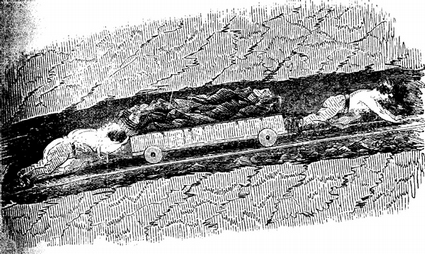Mining in the Victorian Age
Hurrier and thruster, pulling and pushing a loaded coal tub. Illustrated in the Children's Employment Commission, 1842
© NCMME copy photograph
© NCMME copy photograph
Until 1842, one of the most common jobs for women and children working underground was either as a hurrier or thruster.
A hurrier would pull the loaded coal tubs or wagons from the coal face to the bottom of the shaft, while the thruster would push from behind. They would have little time for rest and had to live with the constant fear of explosions or roof-falls. Long hours and poor working conditions affected people's health and ability to work.
Children had little education. Working mothers had to leave very young children with relatives or neighbours and there was a little time left for housework, leisure or family life.
The Factory Act of 1833 restricted the working hours of children in factories and the age at which children could be employed. Many industries, however, were not covered by this Act and by the 1840s Government Commissions were appointed to investigate the working conditions of children in other areas.
A hurrier would pull the loaded coal tubs or wagons from the coal face to the bottom of the shaft, while the thruster would push from behind. They would have little time for rest and had to live with the constant fear of explosions or roof-falls. Long hours and poor working conditions affected people's health and ability to work.
Children had little education. Working mothers had to leave very young children with relatives or neighbours and there was a little time left for housework, leisure or family life.
The Factory Act of 1833 restricted the working hours of children in factories and the age at which children could be employed. Many industries, however, were not covered by this Act and by the 1840s Government Commissions were appointed to investigate the working conditions of children in other areas.


